
Just outside Hazlehurst, Mississippi, a community of 4,000 about 30 miles south of Jackson, lies a poultry farm owned by a Vietnamese farm family whose lives are an amazing story of survival and determination.
Hung and Nancy Pham are refugees who fled the former South Vietnam as teenagers in a shrimp boat during the fall of Saigon in 1975. They were rescued by the U.S. Navy and brought to America. Years after arriving in the United States, the two were reunited through family friends and soon married. Today, the Phams attribute their journey through hardships, their work ethic and positive attitude to the happiness and success they’ve enjoyed as poultry farmers.
“We spent most of our lives in the city after coming to America, but we have loved returning to a healthier, country lifestyle and taking care of the land,” Nancy said.
The Phams were living in Texas when they heard about an out-of-date 105-acre poultry farm for sale in Mississippi. Hung was already working on a poultry farm owned by a family member. After gaining some operational experience, attending poultry seminars and researching the industry, they bought the Mississippi farm in 2006.
“With the old chicken houses not up to modern standards, no compost to manage litter and so many repairs to be made, the place looked more like a junkyard than a farm and was in really bad shape,” Hung said.

Luckily, some neighbors invited Hung to a local meeting where he heard about USDA’s Natural Resources Conservation Service, or NRCS, as well as Farm Bill conservation programs. NRCS has played a vital role in providing technical assistance and guidance to the Phams in using and benefitting from the agency’s Environmental Quality Incentives Programs, or EQIP.
The Phams applied for and received financial assistance through EQIP and began implementing conservation practices on their farm. This included a waste storage facility, also known as a dry stack, which is used to properly store chicken waste or litter, and an animal mortality facility, which composts chicken carcasses to create organic fertilizer for pastureland and cropland.
At full capacity, the Phams can raise 200,000 chickens five times a year for a buyer, which provides the chicks, feed and medicinal requirements. The operational expenses are the Phams responsibility. Their poultry houses are built according to the buyer’s specifications. Every 58-65 days, the grown chickens are picked up, and new chicks delivered to the Phams.
With Hung being the handyman and Nancy keeping a close eye on their finances, they have turned the farm completely around, making it a successful family farm for themselves and their three children.
“The Phams are one of the best landowners and producers we have had the privilege of working with,” said Bill Russell, a supervisory district conservationist with NRCS, who helped the Phams apply for assistance. “They have readily taken every opportunity available from NRCS, plus invested so much of themselves to boost their productivity as well as become environmentally friendly.”



